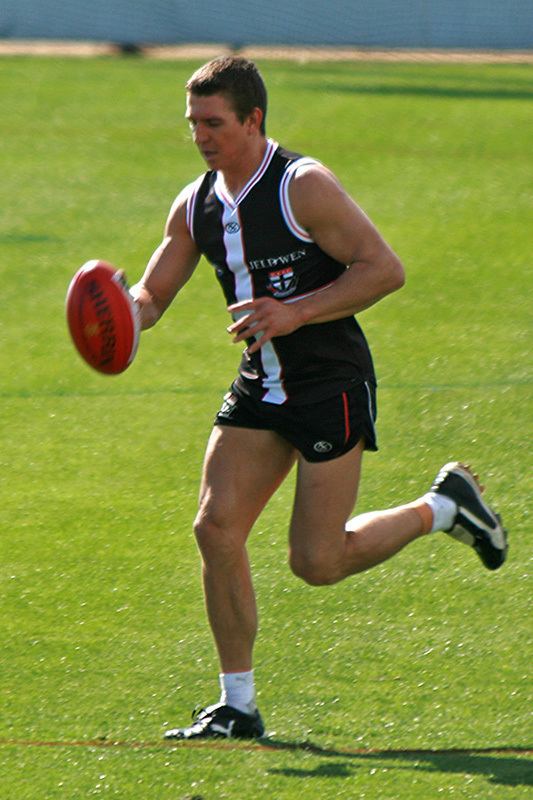 | ||
A running bounce, or simply bounce, is a skill in the sport of Australian rules football (necessitated by the Laws of the Game) when a player, while running, bounces the ball on the ground and back in their hands.
Contents
History
Regarded as "the first distinctively Victorian rule" in the code of Victorian rules football (now Australian rules football), the running bounce was first trialed in 1865 and formalised on 8 May 1866 by a committee of Victorian club delegates chaired by H. C. A. Harrison as a way to slow down the player in possession of the ball and to create more opportunities for a turn over, thus helping to increase the number of disposals and encourage more dynamic team play. Harrison himself was one of the fastest runners in the game, known for his ability to evade opponents while running the length of the field ball-in-hand. Arthur Conan Doyle considered it "very sporting of [Harrison], ... to introduce the bouncing rule, which robbed him of his advantage." The original 1866 rule stipulated that "no player shall run with the ball unless he strikes it against the ground every five of six yards". The rule was well-received by players and spectators alike, and considered attractive to watch.
The skill
Football is played with an ellipsoidal (oval-shaped) ball, rather than a spherical one, so the technique for bouncing one back to oneself while running requires practice. To execute a running bounce, a player should:
Executed properly by a player running at a normal pace, the ball should bounce directly back into their waiting hands.
Players need to readjust the distance of their bounces when running at different paces. When running faster, the ball must be bounced further in front of the player, and when running slower, the ball must be bounced closer. At very slow or stationary paces, this correction is more difficult, because it is difficult to correctly angle the ball for the return bounce at such a short distance.
Australian children (in Australian rules football states) generally learn how to execute running bounces over a few years while they play at school and in junior levels, so to top-level players, the running bounce is a natural skill.
Nevertheless, bouncing an oval-shaped ball is still a volatile skill. Even top level players will occasionally lose the ball while bouncing it, by accidentally bouncing the ball on its point, only to see it quickly skid away from him or her.
Rules
The rules of football state that a player running on the field with the ball must take a running bounce at least once every fifteen metres. If they run too far without taking a running bounce, the umpire pays a free kick for running too far to the opposition at the position where the player oversteps his limit. The umpire signals "running too far" by rolling their clenched fists around each other – similar to false starts in American football or traveling in basketball.
While the distance of 15m is explicit in the rules, the lack of markings on the ground makes it impossible for umpires to accurately judge these free kicks. Regular watchers of football generally have a feel for the average time between running bounces which "feels right", and umpires usually penalise players when they exceed this by more than a few steps.
Touching the ball on the ground
Instead of executing a running bounce, players may bend over and touch the ball onto the ground. It must be touched with both hands or a free kick will be rewarded to the opposing team. This has the disadvantage of taking much longer, increasing the risk of being tackled by an opponent, but it has the advantage of reducing the risk of making a bad bounce and dropping the ball. This technique is often used on rainy days when the mud or water on the ground makes a regulation bounce much more difficult, but is also used by some players, particularly in lower levels, who have yet to master the running bounce.
Statistics
Running bounces are most commonly made by attacking half-back flankers, also known as link-men, or by outside/receiving midfielders. They generally accept the ball from a rebound, and have wide space in front of them to run into, giving teammates time to create options at half-forward. Link-men Jason Gram of St Kilda and Kade Simpson of Carlton, and midfielders Nathan Foley and Brett Deledio of Richmond were both in the AFL-wide top 5 for running bounces in 2007.
Related skills
The requirement that a player performs a specialist skill in order to be allowed to run with the ball is common and necessary in many sports. Introducing these skills prevents players from taking the ball in hand and running the length of the field unchallenged. In this way, the running bounce is related to:
The running bounce should not be confused with the ball-up, also often referred to as a bounce. The ball-up is an unrelated umpiring skill used to restart play from a neutral contest.
